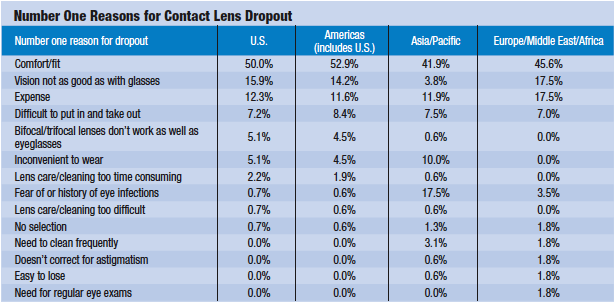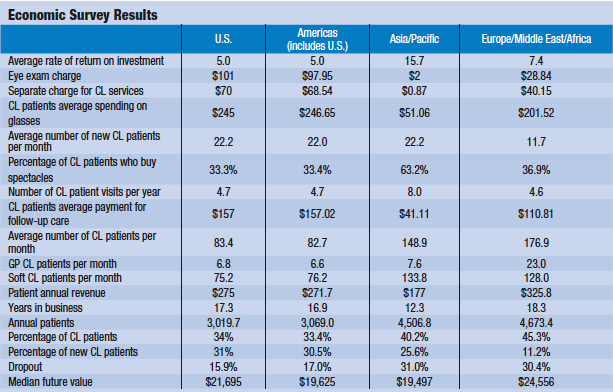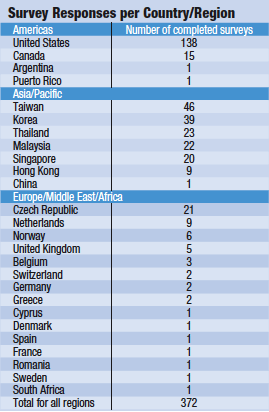Survey Methodology
We conducted a web-based survey in 27 countries around the world. The
surveys were translated into the local languages and economic data were
collected in local currency. Data were collected between January 1,
2009, and June 30, 2009. We received 372 completed surveys (and many
other surveys that were incomplete or incorrectly filled out, and
subsequently discarded.) The top three countries with the most
respondents were the U.S. (138), Taiwan (46) and Korea (39).
We applied an a priori exclusion rule to omit outliers that were
greater than three standard deviations above or below the sample mean.
This rule was applied consistently to all parameters. Because the
sample sizes were relatively small, an extreme value could have had a
large impact on the sample means.
Our hypothesis that the currently reported dropout rate is higher than
10% was statistically assessed using a one-tailed t-test. The t-test is
generally robust to violations of assumptions. Because the dropout
variable was not normally distributed, we performed a transformation by
taking the natural log. We then performed the equivalent t-test to the
transformed data. Dropout rates and the future economic value of a CL
patient were calculated from the survey data.
The causes of CL dropout are frequently misunderstood and underestimated. Likewise, eye care practices tend to underestimate or be unaware of the incidence of CL patients who drop out. Currently, few studies have researched CL patient dropouts. (This is especially true outside of the United States.) Historically, estimates as low as 5% to 10% have been reported for CL patient dropouts.2-4 But, our survey found that dropout rates are as high as 16% to 30%.
Moreover, little is actively being done by the average practitioner to avert this situation. The economic impact on a practice is rarely measured and can be far greater than the practicing optometrist perceives—as much as $24,000 over the lifetime of a single patient who drops out of contact lens wear.
In order to increase awareness, we conducted a global survey to identify the current CL dropout rate, the reasons associated with this dropout, and the resulting economic impact on eye care practices in various regions of the world.
Findings
Globally, eye care providers reported receiving between 12 and 22 new patients each month. On average, the professionals treated seven to 23 gas-permeable CL patients and 75 to 133 soft CL patients per month, depending on their geographic region. Respondents had been practicing optometry for up to 18.3 years on average.

• Dropout rates. The mean dropout rates were 15.9% in the United States, 17.0% in the Americas (including U.S.), 31.0% in Asia/Pacific Rim, and 30.4% in Europe/Middle East/Africa. These rates were all statistically significantly higher than the historically reported rate of 10% (p<0.05). These significant differences were also confirmed with the transformed data.
• Dropout reasons. The top reasons for dropout included discomfort (41.9% to 52.9%), poor vision (3.8% to 17.5%) and expense (11.6% to 17.5%). Among respondents in the Asia/Pacific region, inconvenience (10%) and fear of or history of ocular infections (17.5%) were also important factors contributing to patient dropouts. Conversely, the need for recurring eye exams was not an important reason for patient dropouts (0.0%-1.8%).
• Dropout costs. The average cost of eye care varies across different geographic regions. Eye care professionals charge between $2 and $101 for an eye exam. The survey respondents see, on average, between 83 and 177 CL patients per month. The practices also receive from $177 to $326 per year in revenue for each CL patient. The median future value over the lifetime of a single contact lens dropout was calculated to be $19,497 to $24,556.

Discussion
The accepted dropout rate has often been reported to be about 10%, but ranges anywhere from 5% to 60%.2,4-8 A University of Waterloo study reported the discontinuation rate of CL wearers to be between 26% and 40%.8 Other researchers from the University of Waterloo conducted a survey of 16 practices in Quebec, Canada, and reported an average CL discontinuation rate of 34%.4 A recent study of 730 CL patients at the Ohio State University found a 24% CL patient dropout rate.9
The dropout rate reported in our survey averaged between 15.9% for the U.S. and 31% in Asia. Each region had a discontinuation rate that was statistically significantly higher than 10%. In Asia and Europe, the percentage of patient dropouts actually exceeded the percentage of new CL patients. This underscores the need to address the causes of patient dropout.
 Across all regions of the world, the leading cause for discontinuations in our survey was discomfort. This is consistent with other reports in the literature.4,8-10 University of Waterloo researchers cited the top reasons for discontinuation as discomfort (27%), dryness (16%) and red eyes (11%).8 The more recent University of Waterloo study listed the primary reasons for CL abandonment as discomfort (40% for soft CL and 58% for hard CL) and dryness (10% for soft CL and 11% for hard CL).4 Ohio State University researchers showed that ocular symptoms such as discomfort and dryness were the leading causes of patient dissatisfaction and discontinuation.9 A survey conducted in the U.K. found that 36% of dropouts were related to lens-related factors—the prime example was discomfort.11 The Dry Eye WorkShop Study (DEWS) reported that the primary reasons for CL intolerance were discomfort and dryness.12
Across all regions of the world, the leading cause for discontinuations in our survey was discomfort. This is consistent with other reports in the literature.4,8-10 University of Waterloo researchers cited the top reasons for discontinuation as discomfort (27%), dryness (16%) and red eyes (11%).8 The more recent University of Waterloo study listed the primary reasons for CL abandonment as discomfort (40% for soft CL and 58% for hard CL) and dryness (10% for soft CL and 11% for hard CL).4 Ohio State University researchers showed that ocular symptoms such as discomfort and dryness were the leading causes of patient dissatisfaction and discontinuation.9 A survey conducted in the U.K. found that 36% of dropouts were related to lens-related factors—the prime example was discomfort.11 The Dry Eye WorkShop Study (DEWS) reported that the primary reasons for CL intolerance were discomfort and dryness.12
Other important factors that contributed to dropouts in our study were poor vision, expense, inconvenience and fear of ocular infections. A study conducted in Los Angeles reported that 20% of CL patients failed because of inadequate visual acuity and 8% due to convenience or economic reasons.7
Expense can play a role in CL failures, especially during a global economic downturn. Poor vision can create a need for refitting, but may ultimately lead to CL discontinuation.4,13 Some patients find lens insertion and removal to be bothersome. Others CL dropouts cite lens cleaning regimens as a factor that contributes to their discontinuation.
In our current study, inconvenience (10%) and fear of eye infections (17.5%) were more common complaints for Asian patients than patients in other parts of the world. The level of patient education may influence patient perception with regards to risks involved in contact lens wear.
In some cases, CL patients who drop out may eventually return to the eye care professional for a second fitting. There are several reasons why discontinued patients may elect to resume contact lens wear.4 A survey of 375 patients reported the factors that influenced their willingness to resume lens wear: cosmetic (23%), discomfort resolved (23%), replaced lenses (17%), sports (5%), resolved eye redness (4%), simpler care regimen (3%), work-related reasons (3%), improved finances (2%), wanted to try again (2%) and vision (2%).4
Patients with high-powered prescriptions often find contact lenses a better option for cosmetic reasons. Refitting of the lenses with newer technology or properly matching contact lenses with cleaning solutions can minimize or eliminate discomfort while providing better wearing time. Contact lenses are generally a better option than spectacles for those patients who engage in sporting activities and many patients may experience better vision with their CLs than with spectacles.
The prevention of contact lens dropouts can be influenced by the choice of the multi-purpose disinfecting solution.14 The solution regimen can affect patient comfort, dryness and resultant corneal staining. The practitioner should be more proactive in selecting the optimal lens care products that can enhance lens performance and overall patient wearing experience, thus minimizing the chance for dropouts.14
The economic impact CL patient dropout is significant to an eye care business. The average annual revenue generated by a single contact lens patient can be as high as $326 (in U.S. currency). While this number may not seem significant, the median future value of all CL dropouts for each practice can be more than $24,000—a much more significant dollar figure to the average practitioner.
We must pay greater attention to CL wearers who are at higher risk for dropout. Because the most frequently reported reason for dropout is discomfort, eye care practitioners should select CLs and lens care products that increase comfort and provide good cleaning and disinfection.
Contact lens dropouts are not obvious in most practices; they just tend to fade away. But, they account for significant lost revenue over time. Greater attention paid to all components of the contact lens fit, lenses, modality and care products, all play a significant role in the success of that patient.
We hope that the information presented in the current study serves to further educate eye care professionals about the causes and the prevalence of contact lens patient dropouts. Informed eye care professionals should be well versed in the causes behind contact lens patient discontinuations, address them proactively, and reduce the potential economic effect of patient dropout in their practices.
Further studies involving additional countries would be beneficial in order to gain a better understanding of global trends. This study is ongoing and we expect to report more outcomes in the coming months.
|
Join the Study, Take the Survey This is an ongoing longitudinal study on the rate, the reasons, and the economic impact of contact lens dropouts. If you want to participate in the study, go to: http://GCLAC.PracticeResourceMgmt.com. |
Dr. Rumpakis is the founder of Practice Resource Management, a management and consulting firm. He lectures nationally and internationally on practice management topics, as well as on managed care, contact lenses and refractive surgical procedures. He is Clinical Coding Editor for Review’s “Coding Abstract” column. He has no financial disclosures related to this study.
Julie Crider, Ph.D., a manager of Scientific Communications at Alcon Research, Ltd., contributed to this article. Dr. Crider received support from Alcon. Karen-Marie Eaton and John Colias of Decision Analyst, Inc., participated in the statistical analyses for this project. Decision Analyst, Inc. received support from Alcon Laboratories, Inc.
1. Key JE. Development of contact lenses and their worldwide use. Eye Contact Lens. 2007 Nov;33(6, suppl.):343-5.
2. Asbell PA, Lemp MA. Dry Eye Disease. The Clinicians Guide to Diagnosis and Treatment. New York: Thieme Medical Publishers, Inc.; 2006.
3. Mathers WD. Why the eye becomes dry: a cornea and lacrimal gland feedback model. CLAO J. 2000 Jul;26(3):159-65.
4. Pritchard N, Fonn D, Brazeau D. Discontinuation of contact lens wear: a survey. Int Contact Lens Clin. 1999 Nov;26(6):157-62.
5. Morgan P. Is the UK contact lens market healthy? Optician. 2001;221(5795):22-6.
6. Fonn D, Dumbleton K. Dryness and discomfort with silicone hydrogel contact lenses. Eye Contact Lens. 2003 Jan;29(1, suppl.):S101-4.
7. Schlanger JL. A study of contact lens failures. J Am Optom Assoc. 1993;64:220-24.
8. Weed K, Fonn D, Potvin R. Discontinuation of contact lens wear. Optom Vis Sci. 1993;70(12, suppl.):140.
9. Richdale K, Sinnott LT, Skadahl E, Nichols JJ. Frequency of and factors associated with contact lens dissatisfaction and discontinuation. Cornea. 2007;26(2):168-74.
10. Vajdic C, Holden BA, Sweeney DF, Cornish RM. The frequency of ocular symptoms during spectacle and daily soft and rigid contact lens wear. Optom Vis Sci. 1999 Oct;76(10):705-11.
11. Young G. Why one million contact lens wearers dropped out. Contact Lens Ant Eye. 2004 June;27(2):83-5.
12. Research in dry eye: report of the Research Subcommittee of the International Dry Eye WorkShop (2007). Ocul Surf. 2007 Apr;5(2):179-93.
13. Riley C, Young G, Chalmers R. Prevalence of ocular surface symptoms, signs, and uncomfortable hours of wear in contact lens wearers: the effect of refitting with daily-wear silicon hydrogel lenses (Senofilcon A). Eye Contact Lens. 2006 Dec;32(6):281-86.
14. Stiegemeier MJ, Friederichs GJ, Hughes JL, et al. Clinical evaluation of a new multi-purpose disinfecting solution in symptomatic contact lens wearers. Contact Lens Ant Eye. 2006 July;29(3):143-51.

